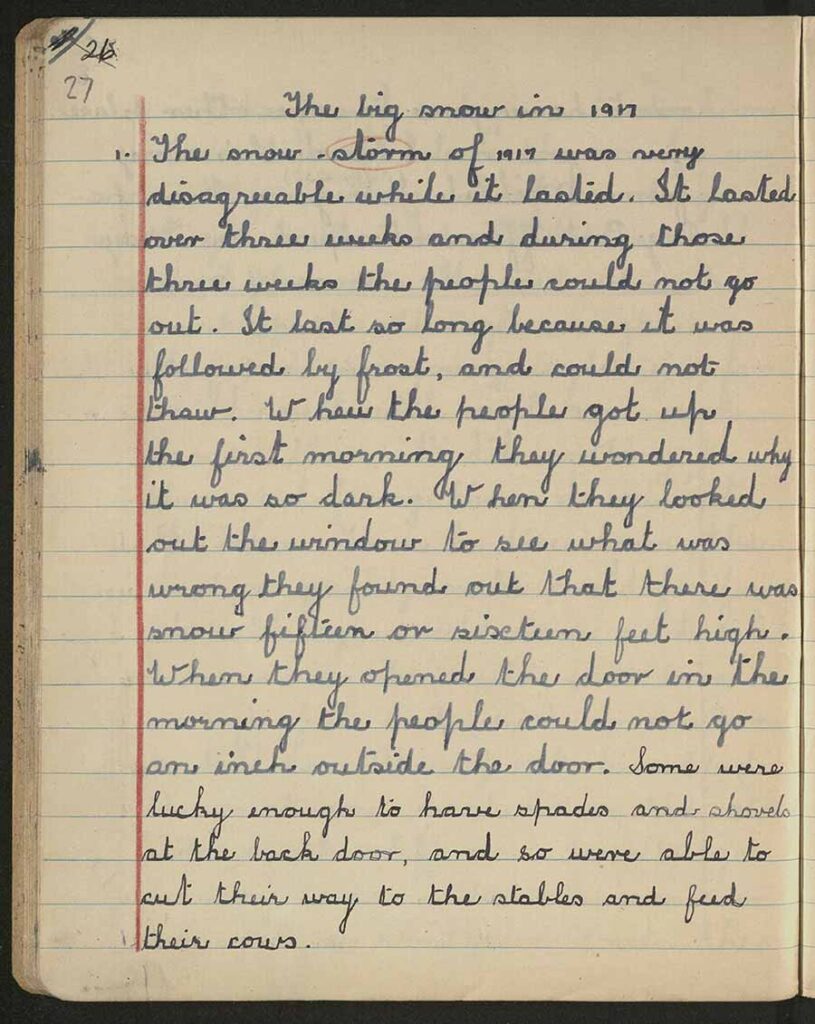
Ireland’s history of severe winters has been documented for more than a millennium but described in detail for just the past four generations. Previous weather events were recorded, but no comparative measurement is possible.
The seven big snows & freezes in the met’s recorded history occurred in 1892, 1917, 1947, 1963, 1982, 2010 & 2018, December 2010 was most extreme in terms of the “depth of cold”, 1963 cold spell was longer, the snowfall of 1947 slowest to melt & 2 snowstorms of 1917 the heaviest.
Notable snowfalls form the annals include an extraordinary three-month-long snowfall around 764 A.D. Severe winters also occurred in 1433/1434 and 1635. The great frost of 1740-41 ultimately led to the deaths of one fifth of the population. The great snow of January 10 1814 cut the roads from Dublin for nine days and horse drawn coaches were abandoned in drifts the length and breadth of the country. New Ross bridge was swept away by the melt after a heavy fall of snow in 1867. .
From the late 17th century onwards, weather records became more detailed thanks to diaries and newspapers. Meteorological observations increased from 1800 onwards, with daily observations starting at Phoenix Park, Dublin, in 1829.
Snowfall in Ireland, a report compiled by Aidan Murphy and published by the meteorological service in 2012, found that snowfalls of at least 10cm happen every 7-18 at midland locations, and every six or seven years in northern areas. The record depth of snow (outside of mountain areas) was 46cm in Cork in 1892, again in Clare in 1917 and 45cm at Casement Aerodrome in Baldonnel on New Year’s Eve in 1962.
1892: Snow disrupted railway traffic throughout February. Snow to a depth of 46cm was recorded in Cork.
1917: On January 25th and 26th, heavy snow covered Ireland, with significant measurements in Ballinacurra and Seskin. The snow persisted until February 18th. A severe snowstorm on April 1st resulted in even greater snowfall, isolating many areas for days. A record equalling 46cm of snow was recorded in east Clare.
1947: Early 1947 experienced the most persistent cold spell of the century, with continuous snowfalls from late January to mid-March. The severe weather caused significant hardship, disrupting communication and transport.
1951: On March 8th, considerable snow fell in midland and eastern areas, followed by cold easterly winds. Mullingar recorded a snow depth of 15cm.
1955: From February 10th to 25th, a cold northerly or easterly airstream brought wintry showers and snow, resulting in icy roads. Dublin Airport had 10 consecutive days with snow lying, reaching a depth of 13cm.
1958: On January 19th, a cold north-westerly airflow brought wintry showers. Malin Head recorded a snow depth of 20cm on February 21st, with Belmullet recording 17cm on February 24th.
1960: February saw widespread snowfall across Ireland. Dublin Airport recorded 9 days of snow lying, with a depth of 11cm on February 13th.
1963: Ireland faced one of the most persistent cold spells from Christmas 1962 to early March 1963. Easterly winds from a large Scandinavian anticyclone brought heavy snowfalls. Casement Aerodrome recorded 45cm of snow on December 31st, 1962. Air temperatures fell below -10°C in many inland areas on January 13th and 14th.
1973: From February 14th to 17th, widespread snow fell, heaviest in the Midlands. Clones, Co. Monaghan recorded a snow depth of 25cm.
1978/79: Between December 28th and 31st, 1978, heavy snowfalls were followed by severe frosts. The cold spell ended on January 6th, but more snowfalls occurred later in January. Casement Aerodrome recorded 26cm, Claremorris 16cm, and Cork Airport 15cm.
1982: A prolonged snowfall on January 8th and 9th, caused by strong easterly winds, resulted in deep snowdrifts. Dublin was severely affected, with Phoenix Park experiencing 8 consecutive days of mean temperatures below 0ºC. Dublin Airport recorded a snow depth of 25cm.
1987: Starting January 11th, heavy snow fell until January 14th, with the East and Midlands being hardest hit. Dublin Airport recorded 19cm, Casement Aerodrome 12cm, and Roches Point 12cm. Roches Point also recorded a minimum temperature of -7.2°C.
2000: On December 27th, a shallow polar depression brought heavy snow to the west and north. Knock Airport recorded a snow depth of 19cm.
2001: Bitterly cold northerly winds from February 26th to 28th brought snowfalls, heaviest in the north and east. The Mourne Mountains recorded a snow depth of 75cm on February 27th.
2009/10: The coldest winter since 1962/63, with temperatures around two degrees below average. Snowfall occurred between 20 and 30 days in many areas, with significant accumulations on high ground.
2010: The cold spell, beginning in November, was notable for its early onset and sustained extreme low temperatures. Casement Aerodrome recorded a snow depth of 27cm, while Dublin Airport measured 20cm. December 2010 saw the most extreme cold in terms of “depth of cold.”
2010/11: From mid-November 2010, progressively colder weather led to snow accumulations. On November 28th, Dublin Airport and Casement Aerodrome recorded their lowest November temperatures, -8.4°C and -9.1°C, respectively. Mount Juliet recorded -16°C on December 3rd. Snow depths ranged from 10 to 25cm, with Casement Aerodrome recording 27cm.
2018: Between February 27th and March 4th, record low temperatures and widespread snowfalls occurred due to a Sudden Stratospheric Warming. Temperatures didn’t rise above freezing during the day, with bitterly cold easterly winds. The depression “Emma” brought additional snow and ice, causing disruptions. Snow depths varied greatly, and significant drifting was reported.
Snow of 1917 in the Schools folklore collection
There was a big snow 21 years ago and it was as high as Kelly’s gable. No one could go to town because there was too much snow. The men were out clearing the snow off the road. The train could not go either because the line was covered with snow. A terrible lot of sheep was lost in the snow. The snow was up over them and they could not walk not eat the grass. Everybody was outside the houses and stables clearing the snow from the doors. The cattle could not get a drink. No one could get water and they had to boil the snow.
The snow storm of 1917 was very disagreeable while it lasted. It lasted over three weeks and during those three weeks the people could not go out. It last so long because it was followed by frost, and could not thaw. When the people got up the first morning they wondered why it was so dark. When they looked out the window to see what was wrong they found out that there was snow fifteen or sixteen feet high. When they opened the door in the morning the people could not go an inch outside the door. Some were lucky enough to have spades and shovels at the back door, and so were able to cut their way to the stables and feed their cows.
A heavy snowfall occurred during the early part of the month of January 1917. There was severe frost for about a week beforehand, then one night there was such a heavy snowfall that doorways were blocked up. It was necessary to do a lot of cleaning away before people could go out. All wells, ponds and streams were frozen, no water to be got. People were obliged to dissolve snow to get water for nearly a week. Snow was piled up everywhere higher than ditches or hedges + in some cases higher than houses. As the snow was frozen hard, people were able to walk along the top of it without sinking, but it was not easy to know where one was going as the whole face of the landscape was hidden. Some funny stories were related about people nearly falling down chimneys. Doctors + nurses were unable to get to patients. Funerals had to be delayed for days. Postal + telegraph communications were suspended. This snow was to be seen on the roadsides + elsewhere even in the month of May
A great snow-storm occurred in this country in 1917. The weather was very cold and frosty in the end of December 1916, and it snowed a little before Christmas but it cleared away again. It began snowing on Thursday night the 28th January and it stayed snowing all day on Friday the 29th until the early hours of Saturday the 30th. The snow was in drifts in some places and some of the drifts were twelve feet deep. Poor people suffered terrible hardship with cold and hunger as they could not leave their homes. In many places the houses were almost covered. In many parts of the country many sheep were lost and more escaped after fourteen days where the drift was not too high. Where it could be afforded snow-ploughs were brought out to clear the roads and the horses often went to their necks in the drifts. It remained on the ground until April and in some parts until May. People were expecting it for a week before it cam as there were many signs of it. The wind was blowing from the North-East and the sky was real red, but then it changed and got very dark and overclouded.

1741 – The Biggest freeze of all
1741: To describe this as the year of the “great frost” is an understatement. In Irish, the year is referred to bliain an áir, the “year of the slaughter”.
A vast and persistent high-pressure system enveloped Ireland and most of Europe, from Scandinavia and Russia down to northern Italy. There was little snowfall, but temperatures plummeted in the clear night skies of early winter and the extreme cold was exacerbated by strong winds. Ships in Dubin bay were damaged by the chunks of ice being carried downriver on the Liffey
First to starve were the dispossessed Irish, the victims of the wars of the previous generations, driven into the mountains and a subsistence economy. They came downhill to scavenge and raid for food, one outcome was Katherine Conolly;s not-son0wodnerful barn, still to this day visible form the M4 near Leixlip, built to protect grain supplies from raiders.
Rivers, lakes, and waterfalls froze, leading to widespread fish deaths. Mill wheels froze and halted the grinding of wheat for bakers, the weaving of cloth for weavers, and processing of rags for printers. People struggled to stave off hypothermia while precious winter fuel supplies dwindled rapidly.
Coal dealers and shippers were unable to land coal from Cumbria and South Wales to ports on the east and south coasts of Ireland which were overcome with ice. People stripped hedges, ornamental trees, and nurseries for alternative fuel sources.
When the frost and its aftermath, which continued for two years, had concluded, it is estimated that up to 20pc of Ireland’s population, which totalled approximately 2.4 million people, perished.



